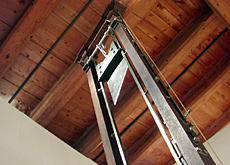Swiss guillotine exhibited for first time

The sole-surviving guillotine in Switzerland is the centrepiece of an exhibition about capital punishment to mark the 350th anniversary of the so-called war against the peasants.
In 1653, cantonal governments crushed a rebellion by inhabitants of rural areas of the country, imposed heavy taxes and forced the peasants to pay the costs of the war.
At that time, the role of capital punishment as an integral part of the penal code was unquestioned, and as the exhibition in Lucerne’s history museum points out, general acceptance of the death penalty decisively influenced the course of the conflict.
The threat of execution inhibited any constructive dialogue between the opposing sides, which might have brought it to an end.
In fact, the principal reason for the conflict was the absence of any opportunity for a discussion of the grievances.
“It was a horrible time,” museum director Heinz Horat told swissinfo, “and the cantons reacted ruthlessly. If the peasants even discussed their problems it was an offence punishable by death. Many were executed by either the sword or by hanging.”
Portable guillotine
The guillotine, which is on display for the first time, was used first in 1845, for the execution of a convicted criminal in Zurich. It was built as a portable device that could be dismantled and transported to different places, including the cantons of Schaffhausen, Fribourg, Valais, Uri, Zug, Obwalden and Lucerne.
“Until the 1870s executions were in public,” said Horat. “After then, they took place in prison courtyards.”
Horat added that the guillotine was used about six times in the first half of the 20th century before the blade fell for the last time, in canton Obwalden in 1940.
Precision instrument
The exhibition also features a scale model of the guillotine, showing it to be much more intricate in design than the French version. Without wanting to sound morbid, it must be said that as an instrument of juridical killing, it bears all the hallmarks of Swiss precision.
Also on display in the museum is a photograph taken by the American artist, Lucinda Devlin, which depicts the electric chair in the execution room of the Greensville Correctional Center in Jarratt, Virginia. Other objects, videos of interviews with prisoners on death row, and books serve to provide further information on this very old but very current penalty which continues to pose a dilemma for society.
Horat points out that while 108 countries – including Switzerland – have abolished capital punishment, 87 others continue to practise it.
Debate
“It is still a subject of debate,” he said, “and we have taken an objective approach. While many governments are opposed, often a majority of their citizens are in favour because they say it acts as a deterrent.
“The counter-argument is that capital punishment fails to have a dissuasive effect… it eliminates the possibility of reversing the verdict should subsequent evidence exonerate the condemned, and it fosters the acceptance of violence and murder.”
“Capital Punishment: Past and Present” is at Lucerne’s history museum until August 31.
swissinfo, Richard Dawson
The exhibition marks the 350th anniversary of the so-called war against the peasants when cantonal governments applied the death penalty to crush rebellion.
Until 1845, convicted criminals were hanged or beheaded by sword.
After that date, several Swiss cantons used the guillotine.
The last surviving guillotine is on public display for the first time in Lucerne’s history museum.
Public executions ended in the 1870s, and the last one took place in a prison courtyard in canton Obwalden in 1940.
According to the museum, 108 countries – including Switzerland – have abolished capital punishment, 87 others continue to practise it.

In compliance with the JTI standards
More: SWI swissinfo.ch certified by the Journalism Trust Initiative
You can find an overview of ongoing debates with our journalists here. Please join us!
If you want to start a conversation about a topic raised in this article or want to report factual errors, email us at english@swissinfo.ch.